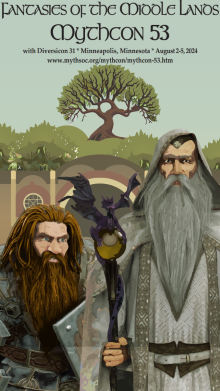Loading...
Location
Minneapolis, Minnesota
Document Type
Presentation
Event Website
https://www.mythsoc.org/mythcon/mythcon-53.htm
Start Date
3-8-2024 11:00 AM
End Date
3-8-2024 11:50 AM
Description
C.S. Lewis famously said of Tolkien in a 1959 letter that “you might as well try to influence a bandersnatch.” He continued by noting that Tolkien had “only two reactions to criticism: either he begins the whole work over again from the beginning or else takes no notice at all.” It’s pretty obvious he had a similar reaction to his own self-criticism – to noticing a loose end, or something that didn’t fit a changed cosmological theory, or a new addition to the legendarium that required a revision to the back-story. His reaction would be to niggle away at a revision or recontextualization, or what we would now call a retcon, in an attempt to create retroactive continuity with the newer narrative or concept, sometimes successfully but perhaps far more often not.We’ll look at Tolkien’s tendency to niggle and revise and reconceive, why he did it, and what it impacts: our understanding 18 of his sub-creative process, how we think about canonicity in the legendarium, how this authorizes (or doesn’t) adaptation and creative re-use by fans and in media, and so on.
Creative Commons License

This work is licensed under a Creative Commons Attribution-NonCommercial-No Derivative Works 4.0 International License.
Included in
The Niggling Bandersnatch: Tolkien’s Revisionist Tendencies and the Canon of Middle-earth
Minneapolis, Minnesota
C.S. Lewis famously said of Tolkien in a 1959 letter that “you might as well try to influence a bandersnatch.” He continued by noting that Tolkien had “only two reactions to criticism: either he begins the whole work over again from the beginning or else takes no notice at all.” It’s pretty obvious he had a similar reaction to his own self-criticism – to noticing a loose end, or something that didn’t fit a changed cosmological theory, or a new addition to the legendarium that required a revision to the back-story. His reaction would be to niggle away at a revision or recontextualization, or what we would now call a retcon, in an attempt to create retroactive continuity with the newer narrative or concept, sometimes successfully but perhaps far more often not.We’ll look at Tolkien’s tendency to niggle and revise and reconceive, why he did it, and what it impacts: our understanding 18 of his sub-creative process, how we think about canonicity in the legendarium, how this authorizes (or doesn’t) adaptation and creative re-use by fans and in media, and so on.
https://dc.swosu.edu/mythcon/mc53/schedule/15


